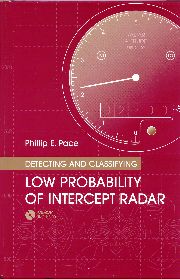
Detecting and Classifying Low Probability of Intercept Radar
Phillip E. Pace
Artech House, 2004, 455 pages

December 24, 2005

 December 24, 2005 |
 adar technology has evolved enormously in the past
twenty years. In the old days, when radar transmitters measured their
ERP in kilowatts, detecting fixed-frequency radars was an almost trivial
task. It would hardly be exaggerating to say that the main difficulty
was not detecting it, but keeping soldiers from getting cooked if they
accidentally stepped in front of the antenna.
adar technology has evolved enormously in the past
twenty years. In the old days, when radar transmitters measured their
ERP in kilowatts, detecting fixed-frequency radars was an almost trivial
task. It would hardly be exaggerating to say that the main difficulty
was not detecting it, but keeping soldiers from getting cooked if they
accidentally stepped in front of the antenna.
Today, the situation is quite different. Clever modulation schemes, including frequency hopping and phase shift keying, have allowed continuous-wave radar to almost completely replace old-fashioned pulse-train radars. Their low peak power (less than 1 watt), low sidelobes (below -40 dB), short "on" times, and huge bandwidth (up to 100 GHz) make intercepting and classifying such signals a challenging task. It is also an important task. Failure to detect even one such signal during a battle can have dire consequences. However, just as modern ciphers are making the adversary's messages unreadable, modern ultrawideband radar technologies are rapidly making the enemy's radar transmissions undetectable. These new radars are called low probability of intercept (LPI) radar. In this book, the technology and theory behind LPI radar is discussed with sufficient clarity and detail that after reading this book and with a little practice, readers could go out and analyze radar signals on their own.
Frequency-modulated CW, or FMCW, is the oldest LPI approach. It works by cleverly spreading the transmitted energy over the modulation bandwidth, which can be as much as one gigahertz. Although simple to implement, FMCW creates high side lobe peaks, which creates many problems, and led to its replacement by phase shift keying (PSK), frequency shift keying (FSK), and frequency hopping. These modulation techniques are explained in detail. To illustrate the approach, a case study of an antiship cruise missile employing FMCW is presented, considering different levels of sea state backscatter.
In the second half of the book, the focus is on receiver and signal interception strategies. Numerical and mathematical tools for analyzing signal parametric data, such as the pseudo Wigner-Ville distribution (PWVD), are thoroughly described. PWVD, a powerful tool similar to Fourier analysis, demonstrates an impressive ability to distinguish and characterize FMCW, polyphase, Frank, and polytime coded signals, even when the signal is well buried in noise. Next, wavelet filters and cyclostationary spectral analysis are used to even more spectacular effect. This is followed by 98 pages of appendices further describing the results of analyses of simulated radar signals for various LPI modulation codes.
The book has a CD with Matlab programs that readers can use to experiment with the algorithms. The book contains numerous 2D and 3D graphs, block diagrams, and equations. The figures are clear but not of particularly high quality.
